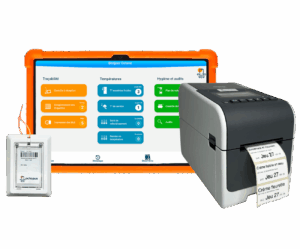HACCP standards in school canteens | Octopus HACCP
Summary
- The fundamentals of HACCP standards in a school canteen
- Key steps to implementing HACCP standards in a school canteen
- Good practices in school kitchens
- HACCP standards in school kitchens
- How does the layout of school canteen premises influence the application of HACCP standards? the application of HACCP standards?
- The importance of cleaning and hygiene in complying with HACCP standards
- Training canteen staff in HACCP principles: methods and benefits
- Cold and hot chain management according to HACCP standards
- How to use sanitary control sheets in the school canteen?
Fundamentals of HACCP Standards in a School Canteen?
School canteen catering primarily follows strict HACCP standards regarding hygiene and food safety for students. Moreover, as part of collective catering, it is legally required to implement a Sanitary Control Plan (PMS) and adapt HACCP standards to optimize food hygiene in school canteens.
Thus, we are talking here about a set of principles and rules that establish good hygiene and food safety practices. This article presents the specificities of HACCP standards and gives you some essential points to comply with these rules in school canteens.
Key Steps to Implement HACCP Standards in a School Canteen?
Firstly, the standard HACCP (Hazard Analysis Critical Control Point) is a system for analyzing food hazards at every stage of production, aimed at controlling and preventing any risk of foodborne illness outbreaks (TIAC). Implementing HACCP standards in a school canteen is part of a broader approach based on a sanitary control plan.
Additionally, this Sanitary Control Plan (PMS) adapted to a school kitchen relies on hygiene prerequisites including:
- Good Hygiene Practices (GHP) and Good Manufacturing Practices (GMP) for a school canteen;
- HACCP standards
✅ Best Practices in School Kitchens
GHPs applied in school canteens cover all aspects that could pose a health risk to both food and students, such as:
- Staff can represent a significant contamination risk if rules are not properly followed. They must receive regular training, whether provided by certified professionals or through a free HACCP training module like those offered by Octopus HACCP;
- Preventive and corrective maintenance of equipment ensured by the school (maintenance contracts with certified suppliers);
- Equipment cleaning. Hygiene measures before, during, and after production cover all kitchen areas. They rely on implementing a cleaning and disinfection plan for all surfaces, equipment, and tools. These specify frequency, products and doses to use, and procedures…
Good manufacturing practices in school kitchens relate to the processes themselves (food and cooking temperatures, dosing…).
Thus, implementing these hygiene prerequisites in school kitchens can be done using the 5 Ms method: materials, equipment, methods, environment, workforce.
HACCP Standards in School Kitchens ⬇️
HACCP standards in school kitchens are based on the following 7 principles:
See image below ?
- Hazard analysis associated with food production;
- Identification of critical control points;
- Establishment of critical limits (what is acceptable and what is not);
- Implementation of monitoring and self-control procedures for critical points;
- Definition and implementation of corrective actions in case of non-compliance;
- Verification of corrective actions’ effectiveness;
- Implementation of a documentation system.

These principles are then supported by forming a multidisciplinary HACCP team, describing finished products and their use, creating a flow diagram for hot and cold production steps, kitchen zones, and product families.
How Does the Layout of School Canteen Premises Influence HACCP Compliance? ?
The layout of the premises is crucial for good hygiene practices. The premises must not be a source of contamination. Their arrangement should facilitate cleaning, circulation of staff, and access to different areas: delivery dock, cold storage rooms, cooking and preparation zones… Restrooms must be located away from food handling areas, and sinks for handwashing must be separate from those used for food.
The Importance of Cleaning and Hygiene in HACCP Compliance
In school catering, cleaning and maintenance plans for premises and equipment are of utmost importance. Failure to meet hygiene prerequisites poses a serious risk of bacteriological contamination of food, causing more or less severe foodborne illnesses. The Octopus HACCP software, an online application developed according to HACCP standards, facilitates the proper execution of cleaning and disinfection plans in school kitchens.
Training School Canteen Staff on HACCP Principles: Methods and Benefits ??
The training of kitchen staff on HACCP principles ensures safety not only of food but also of students in school canteens.
It helps them understand the ins and outs of good hygiene practices and the procedures to follow when handling food. There are two types of HACCP training:
- A mandatory 14-hour HACCP training resulting in a certificate. Only one staff member, the HACCP referent, must complete it;
- Free online HACCP trainings available to all your employees. These sessions, offered by Octopus HACCP, cover all HACCP topics. They help build skills on specific subjects and update knowledge about equipment, procedures, and foodstuffs.
Managing Cold and Hot Chains According to HACCP Standards ??️
Critical points to monitor include food temperature and adherence to the cold chain (0 °C to 3 °C) and hot chain (63 °C maintained from cooking until serving). Food during reception, cold storage, and thawing phases requires systematic temperature checks. The same applies to cold and hot holding for school kitchens located away from the consumption site.
How to Use Sanitary Control Sheets in School Canteens? ?
Sanitary control sheets in school canteens are used to record all actions taken in compliance with the sanitary control plan. Each sheet is systematically filled out with expected readings or completed actions. The operations are dated and all elements must be documented to prove the correct conduct of procedures. The goal is to ensure traceability of actions and foodstuffs in accordance with HACCP standards in school kitchens.
Additionally, these documents are archived to be available for self-inspections or controls by the Departmental Directorate for the Protection of Populations (DDPP). Rather than paper forms, digitize your HACCP procedures and records with the online Octopus HACCP application for greater efficiency!



